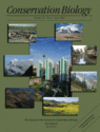
Araújo, M.B.
Ecologists have always been in the business of trying to solve practical conservation problems. Fascinated by progress in physics, mid-20th century ecologists would have rejoiced with the discovery of a formula that unequivocally expressed the universal value of nature. Such formula was never found and despite attempts to develop a synthetic theory of biodiversity value, it was pragmatism that prevailed when conservation planning algorithms were first proposed. Underlying the algorithms, there was not the idea that conservation value of an area equals the total number of species it contains, nor that it amounts to summing numbers of rare species, or any other indicator of biodiversity value. Instead, the value of an area was seen as a relative concept: the contribution of an area to a pre-defined goal. As noted by Adams and Rose (1978), quoting M.D. Hooper, the ‘ultimate criterion’ of conservation planning would amount to buying areas that added “most new species to an existing reserve system” (p.17). It was not until 1983 that the idea was formalized and properly implemented with an algorithm (Kirkpatrick 1983), and the concept of ‘complementarity’, itself, was only coined in 1991 (Vane-Wright et al. 1991). The suggestion that conservation areas should complement each other in terms of the features they contain now underpins a growing number of real-world conservation plans. It also constitutes the key principle of the emerging science of systematic conservation planning (Margules & Pressey 2000).
(...)
Araújo, M.B. 2009. Systematic conservation planning comes to age. Conservation Biology. 23(5): 1332-1333.